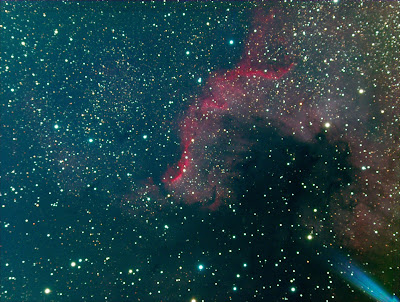Jupiter was visible just after midnight, but low on the southern horizon, along with Saturn. I have the wrong scope for planets but wanted to see what the ZWO camera would be like so took a few thousand frames and stacked in Registax. Only Luminance, so no colour this time. Jupiter's mooons are a bonus.
The main target was the Cygnus Wall in Cygnus, but given the amount of twilight, in total I only have around 4 hours in LRGB, at the usual gain od 139 and exposures of 118s. The blue streak is Deneb, I think, its brightness creeping into the lower right corner.
Wikipedia: The North America Nebula covers an area of more than four times the size of the full moon, but its surface brightness is low, so normally it cannot be seen with the unaided eye. Binoculars and telescopes with large fields of view (approximately 3°) will show it as a foggy patch of light under sufficiently dark skies. However, using a UHC filter, which filters out some unwanted wavelengths of light, it can be seen without magnification under dark skies. Its shape and reddish color (from the hydrogen Hα emission line) show up only in photographs of the area.
The portion of the nebula resembling Mexico and Central America is known as the Cygnus Wall. This region exhibits the most concentrated star formation. The North America Nebula and the nearby Pelican Nebula (IC 5070) are parts of the same interstellar cloud of ionized hydrogen (H II region). Between the Earth and the nebula complex lies a band of interstellar dust that absorbs the light of stars and nebulae behind it, and thereby determines the nebula's apparent shape. The distance of the nebula complex is not precisely known, nor is the star responsible for ionizing the hydrogen so that it emits light. If the star inducing the ionization is Deneb, as some sources say,[citation needed] the nebula complex would be about 1,800 light-years' distance, and its absolute size (6° apparent diameter on the sky) would be 100 light-years.




No comments:
Post a Comment